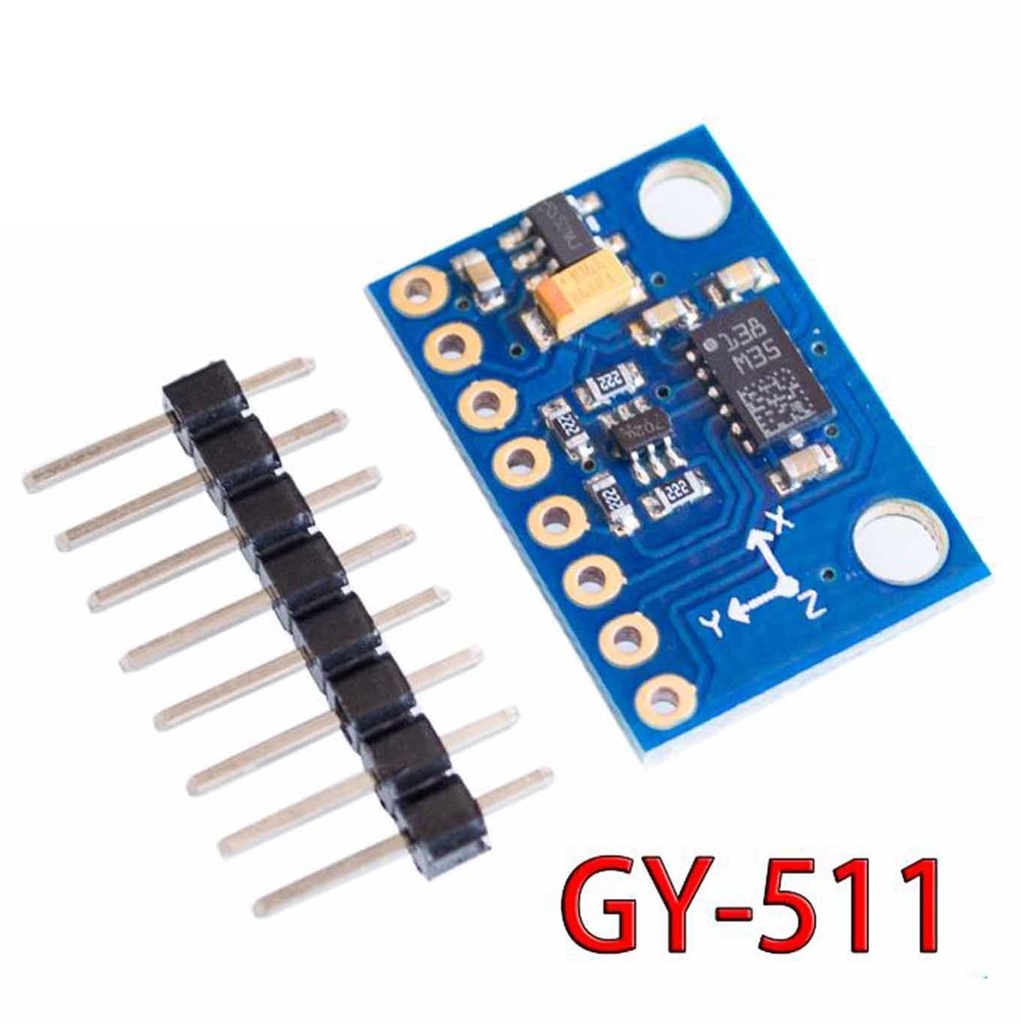Specifications:
- Power supply: 3-5V
- Model: GY-511
- 3 magnetic field channels and 3 acceleration channels
- Magnetic field full scale range: ±1.3 to ±8.1 gauss
- Linear acceleration full scale: ±2g, ±4g, ±8g, ±16g
- 16-bit data output resolution
- I²C serial communication interface
- Power-down and low-power modes supported
- 2 programmable interrupt generators (free-fall, motion detection)
- Embedded temperature sensor
- Built-in FIFO buffer
- 6D/4D orientation detection
- Chip includes 12-bit ADC with 16-bit data output
- Pin pitch: 2.54 mm
- Module size: 20.5mm × 14.5mm
Applications:
- Tilt-compensated digital compasses
- Map rotation and position detection
- Motion-triggered functions
- Free-fall detection and impact logging
- Click and double-click gesture recognition
- Pedometers and fitness trackers
- Power-saving features for handheld devices
- Display orientation adjustment
- Gaming and virtual reality input
- Vibration monitoring and compensation
LSM303DLHC GY-511 Module Pinout:
| Pin |
Name |
Description |
| 1 |
GND |
Ground connection to complete the circuit |
| 2 |
3.3V |
Power supply input (recommended 3.3V) |
| 3 |
SDA |
I2C Serial Data line |
| 4 |
SCL |
I2C Serial Clock line |
| 5 |
INT1 |
Inertial Interrupt 1 (external interrupt request) |
| 6 |
INT2 |
Inertial Interrupt 2 (external interrupt request) |
| 7 |
DRDY |
Data Ready indicator output |
| 8 |
VIN |
Main power supply input (2.5V to 5.5V) |
Arduino Code Example for LSM303 Module:
Before using the code, download and install the LSM303 library.
#include <Wire.h>
#include <LSM303.h>
LSM303 compass;
LSM303::vector running_min = {32767, 32767, 32767};
LSM303::vector running_max = {-32768, -32768, -32768};
char report[80];
void setup() {
Serial.begin(9600);
Wire.begin();
compass.init();
compass.enableDefault();
}
void loop() {
compass.read();
running_min.x = min(running_min.x, compass.m.x);
running_min.y = min(running_min.y, compass.m.y);
running_min.z = min(running_min.z, compass.m.z);
running_max.x = max(running_max.x, compass.m.x);
running_max.y = max(running_max.y, compass.m.y);
running_max.z = max(running_max.z, compass.m.z);
snprintf(report, sizeof(report),
"min: {%+6d, %+6d, %+6d} max: {%+6d, %+6d, %+6d}",
running_min.x, running_min.y, running_min.z,
running_max.x, running_max.y, running_max.z);
Serial.println(report);
delay(100);
}
Specifications:
- Power supply: 3-5V
- Model: GY-511
- 3 magnetic field channels and 3 acceleration channels
- Magnetic field full scale range: ±1.3 to ±8.1 gauss
- Linear acceleration full scale: ±2g, ±4g, ±8g, ±16g
- 16-bit data output resolution
- I²C serial communication interface
- Power-down and low-power modes supported
- 2 programmable interrupt generators (free-fall, motion detection)
- Embedded temperature sensor
- Built-in FIFO buffer
- 6D/4D orientation detection
- Chip includes 12-bit ADC with 16-bit data output
- Pin pitch: 2.54 mm
- Module size: 20.5mm × 14.5mm
Applications:
- Tilt-compensated digital compasses
- Map rotation and position detection
- Motion-triggered functions
- Free-fall detection and impact logging
- Click and double-click gesture recognition
- Pedometers and fitness trackers
- Power-saving features for handheld devices
- Display orientation adjustment
- Gaming and virtual reality input
- Vibration monitoring and compensation
LSM303DLHC GY-511 Module Pinout:
| Pin |
Name |
Description |
| 1 |
GND |
Ground connection to complete the circuit |
| 2 |
3.3V |
Power supply input (recommended 3.3V) |
| 3 |
SDA |
I2C Serial Data line |
| 4 |
SCL |
I2C Serial Clock line |
| 5 |
INT1 |
Inertial Interrupt 1 (external interrupt request) |
| 6 |
INT2 |
Inertial Interrupt 2 (external interrupt request) |
| 7 |
DRDY |
Data Ready indicator output |
| 8 |
VIN |
Main power supply input (2.5V to 5.5V) |
Arduino Code Example for LSM303 Module:
Before using the code, download and install the LSM303 library.
#include <Wire.h>
#include <LSM303.h>
LSM303 compass;
LSM303::vector running_min = {32767, 32767, 32767};
LSM303::vector running_max = {-32768, -32768, -32768};
char report[80];
void setup() {
Serial.begin(9600);
Wire.begin();
compass.init();
compass.enableDefault();
}
void loop() {
compass.read();
running_min.x = min(running_min.x, compass.m.x);
running_min.y = min(running_min.y, compass.m.y);
running_min.z = min(running_min.z, compass.m.z);
running_max.x = max(running_max.x, compass.m.x);
running_max.y = max(running_max.y, compass.m.y);
running_max.z = max(running_max.z, compass.m.z);
snprintf(report, sizeof(report),
"min: {%+6d, %+6d, %+6d} max: {%+6d, %+6d, %+6d}",
running_min.x, running_min.y, running_min.z,
running_max.x, running_max.y, running_max.z);
Serial.println(report);
delay(100);
}
